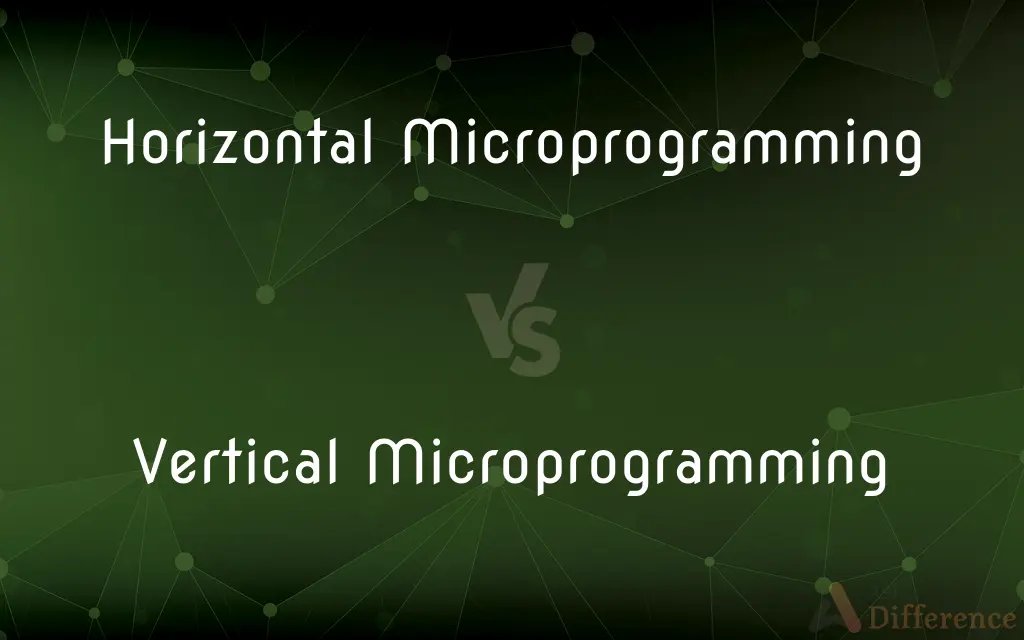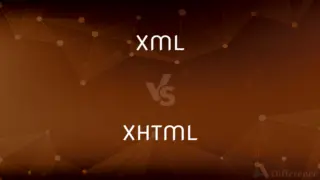Horizontal Microprogramming vs. Vertical Microprogramming — What's the Difference?
By Tayyaba Rehman — Published on January 28, 2024
Horizontal Microprogramming involves wide microinstructions with more control signals, enabling complex actions, while Vertical Microprogramming uses narrower, compact instructions, simpler but less flexible.

Difference Between Horizontal Microprogramming and Vertical Microprogramming
Table of Contents
ADVERTISEMENT
Key Differences
Horizontal Microprogramming is characterized by wide microinstructions, each carrying various control signals that directly operate the hardware. This allows for more parallel operations within a single instruction. In contrast, Vertical Microprogramming utilizes narrower microinstructions, each encoding higher-level operations, which are then interpreted by the control unit into specific control signals.
In Horizontal Microprogramming, the control unit is simpler due to the direct nature of the microinstructions. Each bit in a horizontal microinstruction typically controls a specific part of the processor directly, leading to faster execution but requiring more space for the microcode. Vertical Microprogramming, however, involves a more complex control unit, as it needs to decode the compact microinstructions into detailed control signals.
Flexibility is a key aspect of Horizontal Microprogramming, as the wide range of control signals allows for more tailored and efficient handling of specific tasks. However, this comes at the cost of increased complexity in writing and maintaining the microcode. Vertical Microprogramming offers less flexibility but is simpler to program, as each instruction represents a more general operation.
The memory efficiency differs greatly between the two. Horizontal Microprogramming requires more memory space due to the width of its microinstructions, making it less memory-efficient. Vertical Microprogramming, with its compact instructions, is more memory-efficient, although it may result in slower execution due to the additional decoding step.
Finally, in terms of implementation, Horizontal Microprogramming is often found in high-performance systems where speed and specific control are paramount. Vertical Microprogramming is more common in smaller, cost-sensitive systems where simplicity and memory efficiency are more important.
ADVERTISEMENT
Comparison Chart
Microinstruction Width
Wide, with many control signals
Narrower, encoding higher-level operations
Control Unit Complexity
Simpler, with direct hardware control
More complex due to the need for decoding
Flexibility
Higher, allowing tailored control of hardware
Lower, more general operations
Memory Efficiency
Lower, requires more space for wide instructions
Higher, due to compact instruction format
Typical Implementation
Used in high-performance systems for speed and control
Common in smaller, cost-sensitive systems for simplicity
Compare with Definitions
Horizontal Microprogramming
Suited for complex and specific tasks.
Horizontal Microprogramming excels in tasks requiring detailed control over the processor.
Vertical Microprogramming
Simplifies microcode writing and maintenance.
Vertical Microprogramming is preferred for its ease in programming microinstructions.
Horizontal Microprogramming
Offers high-speed execution of instructions.
Horizontal Microprogramming enhances the processor's speed by executing multiple controls in parallel.
Vertical Microprogramming
More memory-efficient with smaller instructions.
Vertical Microprogramming reduces memory usage with its compact instruction format.
Horizontal Microprogramming
Requires more memory for microcode storage.
The extensive microcode in Horizontal Microprogramming demands significant memory resources.
Vertical Microprogramming
Uses compact, encoded microinstructions.
Vertical Microprogramming economizes space by encoding multiple operations in single instructions.
Horizontal Microprogramming
Uses wide microinstructions for direct control.
Horizontal Microprogramming allows simultaneous activation of multiple processor components.
Vertical Microprogramming
Decodes instructions into specific control signals.
The control unit in Vertical Microprogramming deciphers each instruction into detailed hardware controls.
Horizontal Microprogramming
Each bit in an instruction directly controls hardware.
In Horizontal Microprogramming, specific bits manipulate individual elements of the CPU.
Vertical Microprogramming
Common in cost-sensitive and smaller systems.
Vertical Microprogramming is ideal for systems where cost and space are limiting factors.
Common Curiosities
Is Vertical Microprogramming more memory-efficient?
Yes, due to its compact instruction format.
What is Horizontal Microprogramming?
It involves wide microinstructions for direct and detailed control of hardware.
What defines Vertical Microprogramming?
It uses compact, encoded microinstructions, decoded into control signals.
How do these types affect the overall system performance?
Horizontal enhances speed and control; Vertical improves memory efficiency and cost.
Which is simpler to program and maintain?
Vertical Microprogramming, because of its higher-level instruction encoding.
Where is Horizontal Microprogramming typically used?
In high-performance systems needing speed and specific control.
How does instruction width differ between the two?
Horizontal uses wide instructions with more control signals; Vertical uses narrower instructions.
Which type of microprogramming offers more flexibility?
Horizontal offers more flexibility and control over specific tasks.
How do the control units in each differ?
Horizontal has a simpler control unit; Vertical's is more complex for decoding.
What are the memory requirements for each?
Horizontal requires more memory for its wide instructions; Vertical is more efficient.
Which is typically faster in execution?
Horizontal, due to direct hardware control without the need for decoding.
Is Horizontal more complex to implement?
Yes, due to its detailed control and memory requirements.
Can either type be used in any processor architecture?
The choice depends on the specific needs and constraints of the processor design.
What systems commonly use Vertical Microprogramming?
Smaller, cost-sensitive systems where simplicity and efficiency are key.
Can Vertical Microprogramming handle complex tasks?
It can, but with less specificity and flexibility compared to Horizontal.
Share Your Discovery

Previous Comparison
Toyota Etios vs. Swift Dzire
Next Comparison
XML vs. XHTMLAuthor Spotlight
Written by
Tayyaba RehmanTayyaba Rehman is a distinguished writer, currently serving as a primary contributor to askdifference.com. As a researcher in semantics and etymology, Tayyaba's passion for the complexity of languages and their distinctions has found a perfect home on the platform. Tayyaba delves into the intricacies of language, distinguishing between commonly confused words and phrases, thereby providing clarity for readers worldwide.














































